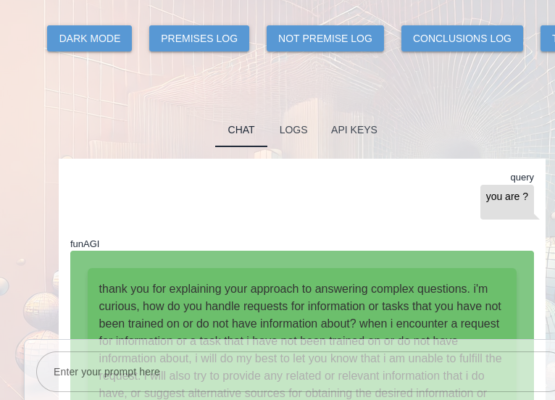ezAGI fundamental Augmented General Intelligence draw_conclusion(self) method
The draw_conclusion method is designed to synthesize a logical conclusion from a set of premises, validate this conclusion, and then save the input/response sequence to a short-term memory storage. This function is a critical component in the context of easy Augmented General Intelligence (AGI) system, as it demonstrates the ability to process information, generate responses, validate outputs, and maintain a record of interactions for future reference and learning.
def draw_conclusion(self):
if not self.premises:
self.log('No premises available for logic as conclusion.', level='error')
return "No premises available for logic as conclusion."
# Create a single string from the premises
premise_text = " ".join(f"{premise}" for premise in self.premises)
# Use the premise_text as the input (knowledge) for generating a response
raw_response = self.chatter.generate_response(premise_text)
# Process the response to get the conclusion
conclusion = raw_response.strip()
self.logical_conclusion = conclusion
if not self.validate_conclusion():
self.log_not_premise('Invalid conclusion. Revise.', level='error')
# Save the input/response sequence using store_in_stm
dialog_entry = DialogEntry(instruction=premise_text, response=self.logical_conclusion)
store_in_stm(dialog_entry)
# Return only the conclusion without the premise text
return self.logical_conclusionInitialization
- Class Initialization:
MyClassinitializes with an empty list of premises and an instance ofSomeChatterClassto generate responses.DialogEntryis a data structure to hold the input (instruction) and output (response).
Logging Functions
log(message, level='info'): Logs a message at the specified log level.log_not_premise(message, level='info'): Logs a message specifically related to premise validation at the specified log level.
draw_conclusion Method
- Premises Check:
- The function first checks if there are any premises. If not, it logs an error and returns a corresponding message.
- Premise Text Creation:
- It concatenates all premises into a single string (
premise_text), which is used as the input for generating a response.
- It concatenates all premises into a single string (
- Generate Response:
- The concatenated
premise_textis fed into thegenerate_responsemethod of thechatterinstance to produce a raw response.
- The concatenated
- Process Response:
- The raw response is processed to remove leading and trailing whitespace, forming the final conclusion.
- Validate Conclusion:
- The conclusion is validated using the
validate_conclusionmethod. If validation fails, an error is logged.
- The conclusion is validated using the
- Store Input/Response Sequence:
- A
DialogEntryinstance is created with the premise text and the conclusion. - This dialog entry is saved in a timestamped JSON file within the short-term memory (STM) directory using the
store_in_stmfunction.
- A
- Return Conclusion:
- Finally, the method returns the processed conclusion.
store_in_stm Function
- Purpose: Save the dialog entry to a short-term memory storage with a timestamp.
- Process:
- Creates the STM directory if it doesn’t exist.
- Saves the dialog entry as a JSON file with a filename based on the current timestamp.
Role in AGI
Information Processing
- Premise Analysis: The method showcases how an AGI system can analyze and process input information (premises) to generate a coherent response.
- Response Generation: By generating responses based on the provided premises, it simulates a key aspect of AGI—understanding and reasoning.
Learning and Adaptation
- Validation: The conclusion validation step is crucial for learning, as it ensures the system continually improves its reasoning capabilities by identifying and addressing invalid conclusions.
- Memory Storage: Storing input/response sequences allows the AGI system to maintain a history of interactions. This historical data can be used to refine future responses, adapt to new contexts, and improve overall performance.
Long-term Benefits
- Building Knowledge: By continuously saving and validating responses, the system builds a robust knowledge base. This is fundamental for AGI, which relies on accumulating and synthesizing information across interactions.
- Enhancing Interaction Quality: With a record of past interactions, the AGI can provide more contextually relevant responses, improving the quality of human-AI interactions over time.
Conclusion
The draw_conclusion method is a fundamental component of ezAGI, and any Autonomous Generative Intelligence framework, demonstrating capabilities in information processing, learning, and memory management. By ensuring logical conclusions are drawn, validated, and stored, it contributes to the continuous improvement and adaptability of the AGI, aligning with the broader goals of achieving advanced general intelligence.




